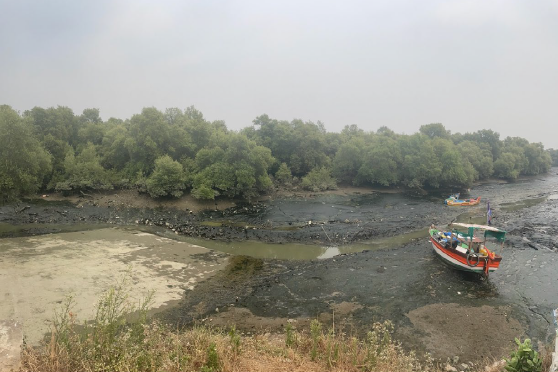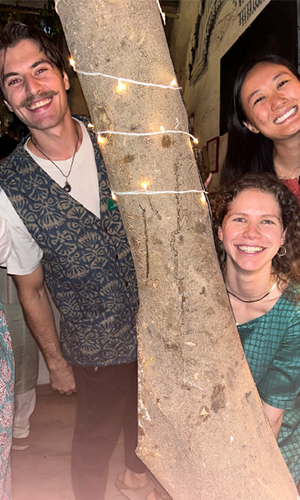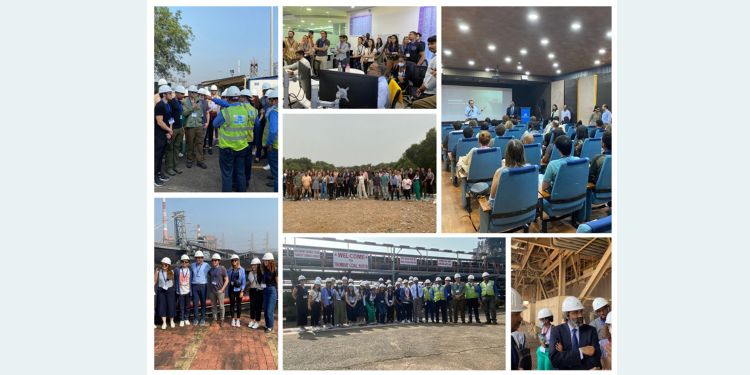Professor Vikram Gandhi’s Immersive Field Course (IFC) “Development while Decarbonizing: India’s Path to Net-Zero" delved into the critical aspect of decarbonization and sustainability goals amid India's rapid development. The course presented an opportunity for students to advance their knowledge of sustainability efforts, decarbonization, and net zero in the context of a broader development agenda. The class culminated in a series of site visits in January 2024 in Mumbai and Bangalore and this is one of 14 student essays that highlights their reflections on uncovering sustainable solutions across the country.
If we must, we will adapt
Prevention would be more apt…
Enlightened citizen participation,
Enables mangrove conservation.
These were wise—and catchy—words shared to our IFC India class by the Chairman of the Board at Godrej Group, Adi Godrej. Mr. Godrej succinctly captured both the optimism and nerves clearly felt among our group regarding the current state of climate change and corporations’ importance in preventing and mitigating the urgent, omnipresent challenge.
Our morning started with a sneak preview of our later visit to the Godrej Group’s headquarters and mangrove forest at a nearby Tata Thermal Power Plant. While peering out from a 150 meter-high coal power plant boiler, we saw a large swath of mangroves in the distance. Later, we arrived at the Godrej headquarters, where we were greeted by Godrej’s Head of Environmental Sustainability, Tejashree Joshi, along with mangrove conservation expert Hemant Karkhanis. Joshi provided an overview to the Godrej Group, its ESG strategy, and its mangrove conservation and restoration initiatives. Godrej Group, an international business conglomerate with business verticals ranging from consumer goods to real estate, leads amongst its peers with environmental initiatives ranging from water conservation, energy use reduction, and “Good & Green” brands. Moreover, Joshi emphasized Godrej’s mangroves as a representation of how Godrej regards the environment in its operations: particularly as a manufacturer, the Godrej Group has a huge potential environmental impact, and the mangroves conserved at the company’s HQ serve as a symbol of company’s social and environmental awareness throughout its supply chain.
Adi Godrej then wowed us with his aforementioned poem, and the Godrej leaders provided thoughtful answers to our questions about mangroves, upcoming initiatives, regulation, corporate governance, partnerships, and more.

Next, at the mangroves, Karkhanis described to us the extent of the flora and fauna around us—dozens of species of butterflies, snakes, trees, and more—both on the ground and from a watch tower, giving us our second bird’s eye view of the day. We were reminded that the environmental crisis is important to us because we are part of the environment. Not only does humanity’s increased carbon emissions and destruction of carbon sinks impact the flora and fauna that surrounds our cities, it also impacts our own health and wellbeing as a species.
Earlier in the afternoon, Adi spoke to us of his uncle “Saurabh-ji”, a critical figure in the Godrej Group company history. Having a predisposition towards nature, Saurabh-ji felt a humanitarian duty to protect and give service to mangrove forests, because the forest was protecting and giving service back to humanity.
This ethos of reciprocal service of mangroves forests to and from people still holds true in the company’s messaging. Godrej Group outlines 4 major categories of services that are provided by Mangroves, which show why conservation is necessary for the well-being of the planet (1):
1. Provision services: Mangroves forests contain food sources eaten by indigenous species and animals (fruits, leaves, fish, prawns, crabs, lobsters, etc), along with medicinal herbs that have been used for centuries in India. Additionally, the ecosystem serves a critical role in regulating the area’s hydrological cycle, ensuring a supply of fresh water
2. Regulating the environment: Mangrove trees are a protective mechanism against sunlight, heat, humidity, erosion, pollution, and storms. They also, of course, sequester carbon in the biomass and sediment.
3. Creating a natural habitat: Mangroves are the natural habitat for a wide range of species, whose feeding, roosting, and breeding cycles depend on the health of these forests.
4. Enriching the community: Natural green-spaces that house biodiversity allows for a felt connection between us and our planet, which can increase our collective mental well-being.
On the bus ride back from our Godrej mangrove visit, our group discussed our reflections on corporate social responsibility and the importance of collaboration with the private sector. Though the efforts of the Godrej Group to conserve Mangrove forests seems to have been effective and positive for the environment, it seemed to be largely unrelated from their core lines of business, which spans locks, agriculture, aerospace, and many more industries. Still, they spend considerable time and effort in conserving the mangroves that reside on ⅔ of its headquarters land just outside of Mumbai.
India has an interesting CSR policy, which came up a few times in our conversations with companies. In 2013, India enacted a law requiring that companies above a certain size threshold spend 2% of their net profits every year on CSR initiatives within certain categories (2). We were impressed by this mandate and the corresponding magnitude requirement, particularly in a context with such wide inequality between the top and bottom of the pyramid. Interestingly enough, the Godrej Group’s CSR initiatives do not include the mangrove conservation project, but are instead focused around skills & livelihoods, public health, waste management, and watershed management (3). As we discussed extensively during our visit, mangroves have the potential to offer many ecosystem services beyond carbon capture - namely, providing livelihoods for local communities and fisherpeople and helping preserve the integrity of local waterways.
We walked away heartened that the Godrej Group had maintained its mangrove plots and were engaging with other mangrove initiatives to share best practices, but one thing we hope for more of in the future is a government or nonprofit-led initiative to coordinate various mangrove conservation and restoration initiatives across India. The Godrej Mangroves, though powerful, are only in one small swath of India’s coastline, and in order for mangroves to serve as the deep natural carbon sinks they have the potential to be, we need to look to a future with clear-set goals for healthy mangrove acreage and coordinated support and action to achieve that.

Source:
1. https://mangroves.godrej.com/ecosystem-importance.html
2. https://knowledge.wharton.upenn.edu/article/how-indias-csr-experience-can-shape-esg-strategies/
3. https://www.godrejcp.com/sustainability/csr

